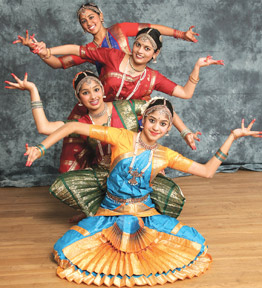Pedagogical traditions in Classical Bharatha Natyam
Subashini Pathmanathan
In classical tradition guru (the teacher) Shishya (student)
relationship is sacred. The guru is looked upon as a mentor for the
student, not only in the dancing career but also in general life. It is
best for a student to study the art under one and the same guru
throughout.
In olden days the disciples irrespective of their family background
used to stay with their guru at the guru's residence.
During his or her stay with the guru, the Shishya was supposed to
serve the guru and get vigorous training in the art form. The
traditional Gurus' resident students were referred to as Gurukula
students.
Years of practice
They spent maximum time with the guru and acquired thorough knowledge
and vigorous practical training under the same Guru for many years. This
type of traditional training is called as guru shishya parampara
(generation).
 |
|
Students
spent maximum time with teachers |
The students who learnt the art under such methodology would devote
themselves, wholly to the art form and become involved with the art
fully. In shishya parampara tradition the Shishyas would become fully
dedicated, and devoted to the art form.
The ancient thesis laid down certain qualities for the Guru. This was
called Gurulakshanam. Such Gurulakshanam was not only necessary for the
olden Gurus of this divine art form but also needed for the present
generation Gurus.
A Guru must posses a thorough knowledge of all aspects of the art
form including theory, and practice.
In case of necessity the Guru must dance and demonstrate to the
students. Guru must posses certain good qualities such as patience,
discipline, peaceful mind, charm, politeness, and kindness, caring
towards the students.
Treating alike
And treat all the students alike, irrespective of their family
background. Meanwhile the teacher must maintain firm discipline while
taking the lessons.
There are ancient Shastras or these laid down guidelines for a dance
guru. Those techniques were known as thanthras, there are altogether
five.
One is matcha thanthra, it means that the Guru must impart the art in
a very perfect manner, and leave it to the students to improve it on
their own, just as how the fish hatches its eggs by glancing them.
Kurma Thanthra, means that the guru trains the student and by his
thoughts he induces the students to develop the art as how the tortoise
lays its eggs on the earth, and let them hatch there, through its
willpower while the tortoise is in the water.
Bharmara Thanthra, the guru keeps a continuous watch on the Shishya,
which provides an opportunity for the Shishya to develop and acquire
high standard in the art. Next is Marjara Thanthra, the guru keeps on
watching the shishya until the shishya acquires full knowledge and
efficiency in the art just as how the cat protects its kittens until
they reach the stage of self-sufficiency.
Following traditions
Last is Markata Thanthra, which means that like the monkey which
always carries its baby wherever it goes. Similarly the Shishyas also
must go with the Guru wherever he goes. All these Thanthras are based on
the Guru's manotharmam.
Shishyas also must possess certain qualities, such as general
intelligence, enthusiasm, self motivation, self interest, ability to
work hard, struggle to come up, cooperate with the Guru, self
determination, pay obedience to the Guru, pay devotion and dedication to
the art.
Through this, the students could be divided into four divisions, one
is uttama, means superior, matima means mediocre, adhana below average,
adhamadhana means inferior.
But unfortunately today the mentality of the students and the
teachers are totally changed. The students and the teachers are alike
seeking publicity, through media. Teaching dance has become totally
commercialized.
|





